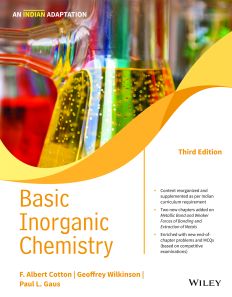Basic Inorganic Chemistry, 3ed (An Indian Adaptation)
ISBN: 9789354246913
796 pages
Publication Year: 2021
For more information write to us at: acadmktg@wiley.com

Description
This Indian adaptation edition offers new and updated content while retaining the conceptual strength of the original. Two new chapters have been added to the book to make the coverage complete as per Indian curriculum requirement—Metallic Bond and Weaker Forces of Bonding and Extraction of Metals. Reorganization and addition of new topics in chapters aim to align the book better with the syllabus flow. Some new topics include Dipole Moments and Molecular Polarity, Geometries of Crystal Lattices, Effective Atomic Number Concept, Solvent Levelling, and Differentiating Effects, Borazine, Structure, and Nature of Hydrides, Sulfur-Nitrogen Compounds, Bonding and Molecular Orbital Diagram of Ferrocene, Metal ions in Biological Systems and more
Part 1 First Principles
Chapter 1 Some Preliminaries
Chapter 2 The Electronic Structure of Atoms
Chapter 3 Structure and Bonding in Molecules
Chapter 4 Ionic Solids
Chapter 5 Metallic Bond and Weaker Forces of Bonding
Chapter 6 The Chemistry of Selected Anions
Chapter 7 Coordination Chemistry
Chapter 8 Solvents, Solutions, Acids, and Bases
Chapter 9 The Periodic Table and the Chemistry of the Elements
Chapter 10 Extraction of Metals
Part 2 The Main Group Elements
Chapter 11 Hydrogen
Chapter 12 The Group 1(IA) Elements: Lithium, Sodium, Potassium, Rubidium, and Cesium
Chapter 13 The Group 2(IIA) Elements: Beryllium, Magnesium, Calcium, Strontium, and Barium
Chapter 14 Boron
Chapter 15 The Group 13(IIIB) Elements: Aluminum, Gallium, Indium, and Thallium
Chapter 16 Carbon
Chapter 17 The Group 14(IVB) Elements: Silicon, Germanium, Tin, and Lead
Chapter 18 Nitrogen
Chapter 19 The Group 15(VB) Elements: Phosphorus, Arsenic, Antimony, and Bismuth
Chapter 20 Oxygen
Chapter 21 The Group 16(VIB) Elements: Sulfur, Selenium, Tellurium, and Polonium
Chapter 22 The Halogens: Fluorine, Chlorine, Bromine, Iodine, and Astatine
Chapter 23 The Noble Gases
Chapter 24 Zinc, Cadmium and Mercury
Part 3 Transition Elements
Chapter 25 Introduction to the Transition Elements: Ligand Field Theory
Chapter 26 The Elements of the First Transition Series
Chapter 27 The Elements of the Second and Third Transition Series
Chapter 28 Scandium, Yttrium, Lanthanum, and The Lanthanides
Chapter 29 The Actinide Elements
Part 4 Some Special Topics
Chapter 30 Metal Carbonyls and Other Transition Metal Complexes with p-Acceptor (p-Acid) Ligands
Chapter 31 Organometallic Compounds
Chapter 32 Stoichiometric and Catalytic Reactions of Organometallic Compounds
Chapter 33 Bioinorganic Chemistry
Chapter 34 The Inorganic Solid State
Appendix I Aspects of Symmetry and Point Groups
Appendix IIA The Schrödinger Wave Equation
Appendix IIB Ionization Enthalpies of the Elements
Appendix IIC Ionic Radii
Appendix IID Electron Attachment Enthalpies of Selected Elements
Appendix IIE A Comparison of Electronegativity Values (Pauling Units) from Four Sources
Appendix IIF Some Spot Test Reagents
Glossary
Index

